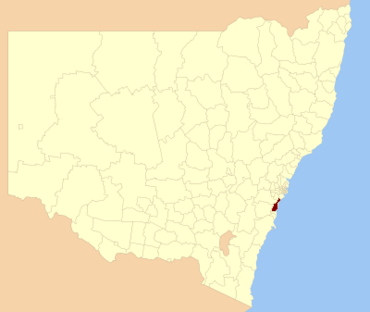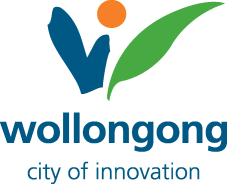City of Wollongong facts for kids
Quick facts for kids City of WollongongNew South Wales |
|||||||||||||||
|---|---|---|---|---|---|---|---|---|---|---|---|---|---|---|---|

Location in NSW
|
|||||||||||||||
| Population |
|
||||||||||||||
| • Density | 297.70/km2 (771.0/sq mi) | ||||||||||||||
| Established | 1942 (as the City of Wollongong) | ||||||||||||||
| Area | 684 km2 (264.1 sq mi) | ||||||||||||||
| Lord Mayor | Gordon Bradbery | ||||||||||||||
| Council seat | Wollongong | ||||||||||||||
| Region | Illawarra | ||||||||||||||
| State electorate(s) |
|
||||||||||||||
| Federal Division(s) |
|
||||||||||||||
 |
|||||||||||||||
| Website | City of Wollongong | ||||||||||||||
|
|||||||||||||||
The City of Wollongong is a special area in New South Wales, Australia, that has its own local government. It's located in the Illawarra region, right next to the Tasman Sea. You can also find it near the Princes Motorway and the Illawarra railway line.
This area is about 80 kilometres (50 mi) south of Sydney central business district. It covers about 714 square kilometres (276 sq mi) of land. The City of Wollongong is a narrow strip along the coast. To the north, it's bordered by the Royal National Park. To the south, you'll find Lake Illawarra. The Tasman Sea is to the east, and the Illawarra escarpment (a steep cliff line) is to the west.
The leader of the City of Wollongong Council is the Lord Mayor, Councillor Gordon Bradbery. He is an independent politician, which means he doesn't belong to a major political party.
Contents
Places in Wollongong
The City of Wollongong includes many northern and central suburbs of Wollongong. Its northern boundary is Helensburgh. The Illawarra escarpment forms its western edge. To the south, it reaches Macquarie Rivulet (near Yallah and Haywards Bay) and the entrance to Lake Illawarra (at Windang).
Who Lives Here?
This section tells us about the people who live in the City of Wollongong.
Population and Age
In 2011, there were about 192,418 people living in the City of Wollongong. Slightly more than half were female (50.5%), and 49.5% were male. About 2.2% of the people were Aboriginal and Torres Strait Islander people.
The average age of people in Wollongong was 38 years. About 18.5% of the population were children aged 0 to 14 years. People aged 65 and over made up 16.4% of the population.
Backgrounds and Languages
Many people in Wollongong have ancestry from Australian or Anglo-Celtic backgrounds. This means their families originally came from places like England, Ireland, or Scotland.
Most residents in Wollongong identify with Christianity. About 79.4% of households speak English only at home. However, many people also speak other languages. Some of the most common languages spoken at home, besides English, include Macedonian, Italian, Arabic, and Mandarin.
Wollongong's History
The name Wollongong comes from an Aboriginal word, woolyungah, which means "five islands." Aboriginal people have lived in this area for at least 30,000 years. The Wodi Wodi tribe is the traditional Aboriginal group of the Illawarra region.
Early Settlement
The first European settlement in the area began in 1815. Dr Charles Throsby brought his cattle from the Southern Highlands to a freshwater lagoon near South Beach. The town of Wollongong was officially planned in 1834.
Steel Industry Growth
A big part of Wollongong's history is its steel industry. In 1927, Charles Hoskins made a deal with the New South Wales Government to build a steelworks at Port Kembla. This started a long tradition of steel production that continues today. The steel industry helped the city grow a lot and shaped its economy and culture for many years.
How Wollongong Became a City
Local government in the Illawarra region began a very long time ago, in 1843. Back then, it was called the Illawarra District Council.
Later, in 1859, the Municipality of Wollongong was officially created. It was one of the first areas in New South Wales to have its own elected council. The first mayor of Wollongong was John Garrett.
Over time, other nearby areas also formed their own councils, like Central Illawarra, North Illawarra, and the Shire of Bulli.
Wollongong was officially declared a "city" on September 11, 1942. Then, in 1947, the City of Wollongong joined with the Shires of Bulli and Central Illawarra, and the Municipality of North Illawarra. They all combined to form the City of Greater Wollongong.
On April 10, 1970, Queen Elizabeth II gave the city the special title of "Lord Mayoralty." Soon after, on October 30, 1970, the city went back to its original name, "City of Wollongong."
The city's motto is "Urbs Inter Mare Montemque", which means "City Between the Mountains and the Sea." Its slogan is "City of Innovation."
Future Plans
In 2015, there was a suggestion to combine the City of Wollongong with the City of Shellharbour to create a larger council area. However, in February 2017, the New South Wales Government announced that these two council areas would not be combined.
Wollongong's Culture
Wollongong is proud of its industrial past and is known as an important industrial center in Australia. While steel and manufacturing are still key industries, the city has also grown in other areas.
Tourism is becoming more important, especially with the beautiful Sea Cliff Bridge to the north. Other growing industries include information technology, hospitality (like hotels and restaurants), health services, and telecommunications.
Wollongong has a strong sense of community and a rich cultural heritage. People from over 30 different language groups and 20 religious backgrounds live together peacefully. This mix of cultures adds to the city's vibrant life and makes it a diverse and interesting place.
Images for kids
-
Wollongong City Council administration building, located in Burelli Street, Wollongong.


